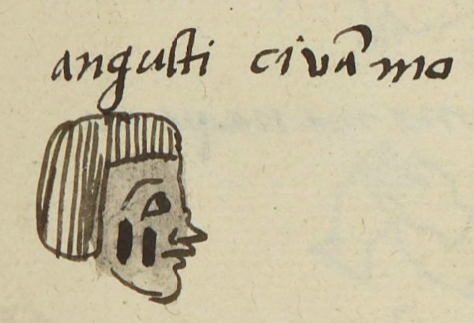Cihuaman (MH555r)
This black-line drawing of a simplex glyph stands for the personal name Cihuaman (seemingly short for Cihuamani, “Woman-Like”). It is attested here as a man’s name. It shows just the face of this man, with the addition of two, short, vertical, thick black lines on his cheek. These hash marks recall the "double-strike" phonogram for the syllable "hua" (from the verb huahuana, to incise lines). The start of this name, if we trust the gloss, is Ci-, which is not shown visually, unless the double stripes on the cheek go as far as to say "cihua" in this case (more than just "hua"). The -mani part of the name, apparently from mani (to be like) is not shown visually, either.
Stephanie Wood
This sign for "hua" also appears in various place names in the Codex Mendoza. One of these signs is on the cheek of a woman. Perhaps this scribe was familiar with that glyph from two decades earlier, or it had indeed lived on, and he was taking a shortcut with the visual dimensions of the name by not drawing a woman's head. The gender implications of the name for this man are intriguing.
Stephanie Wood
angusti civāman
Agustín Cihuaman[i]
Stephanie Wood
1560
woman, women, mujeres, possessor, possessive, posesivo, nombres de hombres

cihua(tl), woman, https://nahuatl.wired-humanities.org/content/cihuatl
mani, to be in the manner of, https://nahuatl.wired-humanities.org/content/mani-1
A La Manera de una Mujer
Stephanie Wood
Matrícula de Huexotzinco, folio 555r, World Digital Library, https://www.loc.gov/resource/gdcwdl.wdl_15282/?sp=189&st=image.
This manuscript is hosted by the Library of Congress and the World Digital Library; used here with the Creative Commons, “Attribution-NonCommercial-ShareAlike 3.0 License” (CC-BY-NC-SAq 3.0).





